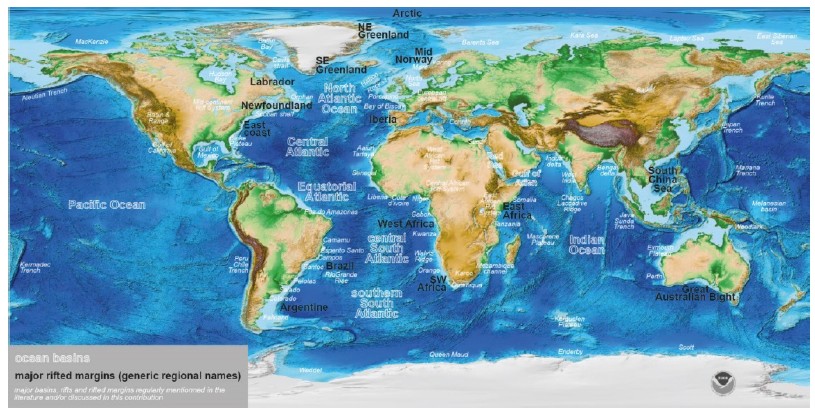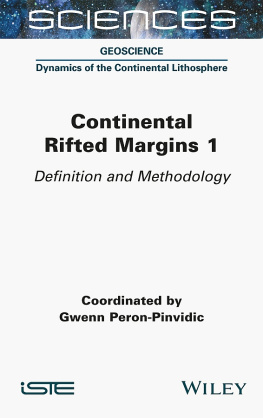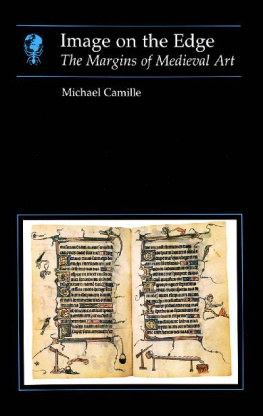
SCIENCES
Geoscience, Field Director Yves Lagabrielle
Dynamics of the Continental Lithosphere,
Subject Head Sylvie Leroy
Continental Rifted Margins 1
Definition and Methodology
Coordinated by
Gwenn Peron-Pinvidic

First published 2022 in Great Britain and the United States by ISTE Ltd and John Wiley & Sons, Inc.
Apart from any fair dealing for the purposes of research or private study, or criticism or review, as permitted under the Copyright, Designs and Patents Act 1988, this publication may only be reproduced, stored or transmitted, in any form or by any means, with the prior permission in writing of the publishers, or in the case of reprographic reproduction in accordance with the terms and licenses issued by the CLA. Enquiries concerning reproduction outside these terms should be sent to the publishers at the undermentioned address:
ISTE Ltd
27-37 St Georges Road
London SW19 4EU
UK
www.iste.co.uk
John Wiley & Sons, Inc.
111 River Street
Hoboken, NJ 07030
USA
www.wiley.com
ISTE Ltd 2022
The rights of Gwenn Peron-Pinvidic to be identified as the author of this work have been asserted by her in accordance with the Copyright, Designs and Patents Act 1988.
Any opinions, findings, and conclusions or recommendations expressed in this material are those of the author(s), contributor(s) or editor(s) and do not necessarily reflect the views of ISTE Group.
Library of Congress Control Number: 2021950855
British Library Cataloguing-in-Publication Data
A CIP record for this book is available from the British Library
ISBN 978-1-78945-061-3
ERC code:
PE10 Earth System Science
PE10_5 Geology, tectonics, volcanology
PE10_7 Physics of earths interior, seismology, volcanology
PE10_11 Geochemistry, crystal chemistry, isotope geochemistry, thermodynamics
PE10_12 Sedimentology, soil science, palaeontology, earth evolution
Preface
Gwenn PERON-PINVIDIC
Geological Survey of Norway (NGU), Trondheim, Norway
Department of Geoscience and Petroleum, Norwegian University of Science and Technology, Trondheim, Norway
Continental margins mark the transition between continents and oceans, which are the two first-order types of land masses on Earth. Active continental margins are associated with convergent lithospheric plates where collisional processes occur they are the sites of intense tectonic, seismic and volcanic activity; while passive continental margins correspond to the regions that mark the rupture of a continent and the opening of an ocean basin, ultimately leading to the establishment of an oceanic ridge. Passive margins archive two of the most fundamental geological processes operating on Earth: rifting and breakup. Passive continental margins, also often referred to as rifted margins, register the extension and ultimate separation of the continental lithosphere and the beginning of oceanic crust accretion. After continental breakup, they are tectonically quieter than the active margins.
Rifted margins contribute to our understanding of extensional processes in the continental lithosphere in several ways. First, they represent the most widespread manifestation of Mesozoic and Cenozoic extensional deformation, archiving the structures created during the dismembering of the supercontinent Pangea, a major stage in the tectonic history of our planet. In addition, they border almost all of the land masses that surround the Atlantic, Indian, Antarctic and Arctic Oceans and represent significant surfaces of todays Earth. Moreover, since they represent the final stage of evolution of an intracontinental rift zone, they can provide a complete record of extensional history and are therefore unique geological features.
Rifted margins are studied by various disciplines of Earth Science (geology, geophysics, geochemistry). Thanks to an increasing amount and better public access to high-quality data, there has been a great improvement in our understanding over the last two decades. However, there are still important debates happening in the scientific community on several questions. Their structural architecture, as well as their spatial and temporal evolution, are still being discussed. No strict consensus has been reached on the composition of the basement, tectonic structures, sedimentary geometries or magmatic content. Correspondingly, their relationship with the adjacent oceanic areas, specifically the first kilometers of oceanic crust, is still largely unconstrained.

Figure P.1. Topographic map of the world with the major ocean basins, rifted margins and main geological structures regularly mentioned in the literature and/or in this book
How to use this book
This book focuses on continental rifted margins, with the aim of explaining the status of knowledge and the way in which understanding has evolved over the last few decades, thanks to the scientific community. Concise text descriptions are used throughout to ensure the content is practical and accessible. We have also incorporated myriad schemas and illustrative figures in all chapters in order to reach a wide audience, particularly students. For further detailed information, the reader is referred to key publications listed under the Further reading sections.
The book is designed to be a useful tool for students and those who are new to the rifted margin community a sort of cookbook to facilitate the reading of scientific publications and provide basic definitions and explanations on a series of key scientific questions. No detailed information is given on the methods: only succinct reminders are provided. If interested, readers are referred to books and contributions specifically dedicated to these topics. Here, the focus is directed towards the rifted margin itself by providing fundamental definitions and explaining how we study these features, how the current theories were developed, where our understanding of rifted margins currently stands and where we are headed as a research community.
Overview
The book comprises two volumes and is structured into three main parts:
Volume 1 includes describes in further detail how rifted margins are classified spanning the different categories usually found in the literature (e.g. divergent vs. oblique, volcanic vs. non-volcanic, sediment rich vs. sediment starved). The chapter summarizes the evolution of knowledge and understanding achieved by the scientific community over the last few decades, from the initial models proposed in the 1980s to the modern views discussed today. The final part of the chapter then lists and discusses a series of scientific questions selected to illustrate the future scientific challenges our community is facing.
focus on the modeling strategy, including both analogue and numerical approaches.
Volume 2 includes Part 3, which is made up of nine chapters. These chapters illustrate the topics by reviewing a series of case examples considered to be representative of the most discussed study sites at present. The aim of this part of the book is to cover a wide range of rifted margin categories, with both onshore archives and modern offshore cases.
Next page








